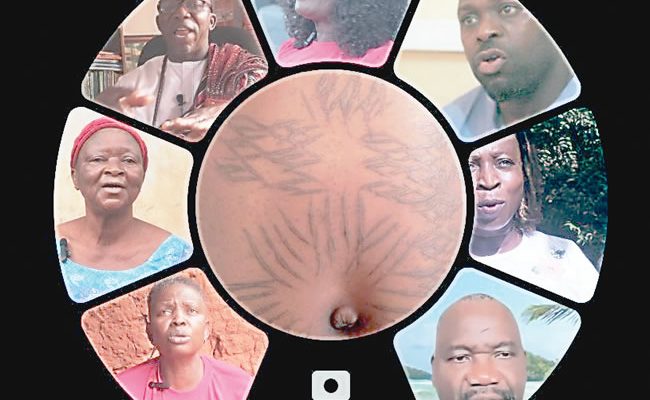
POET and festival administrator Samuel Osaze has released a documentary film, ‘Ema/Udeh’ (Ancient Healing Tattoo of the Esan People), used in treating enlarged spleen.
With TerhAgbedeh as director of photography and Otatane-Oso Andrew as editor, the movie delves into the ancient practice of traditional body marking and its multiple functionalities. It also attempts to depict the ancient practice without bias or prejudice, questioning the practitioners and people from the town and gown.

The contributors include academics and orthodox medical experts, each articulating divergent views for the public’s engagement. The exploration of ‘Ema/Udeh’, reportedly effective in treating enlarged spleen, is informative and aims to raise debate over traditional practices compared with modern medical methods, commonly referred to as ‘orthodox methods ‘, believing they would lead to improvements and synergy for better-quality healthcare.
The documentary features scholars such as Professor of Dance Studies and Performance Aesthetics Mariam Asabe Iyeh and Professor of Philosophy Matthew A. Izibiland. The medical experts, Doctors AlojaAirewele and Abel Toms-Oriakhiebring their extensive knowledge to the discussion. The traditional tattoo artists involved in the practice to save lives, not make earnings, are all women-Justina Okoh, Martha Wilson, and Anthonia Imhanlu.
The film raises and answers questions about this intriguing practice, mostly bordering on how to improve further and mainstream it. Some questions are: Are there grounds for comparing the modern tattoo and the ancient Esan body marking? How is Ema /Udeh carried out? What could be responsible for its continuing popularity, or what does the Ema/Udeh offer that modern medical methods lack in curing the same ailment? The others are: how genuine is the claim that orthodox medical procedures cannot cure splenomegaly (enlarged spleen)? Is splenomegaly endemic to Esan/Edo people, and if not, how do people of other ethnic groups treat the ailment? How could the ancient practice be improved and aligned with global standard health practices?
Osaze commented: “Ema/Udeh does not only cure: a truth it has proved amid many doubts. It also leaves carefully curated artistic footprints for the bearer and the public to admire, making the bearer a mobile canvas of the tattoo artist. Thus, the Ema/Udeh artists can maintain the dual functionalities of a healer and an artist wrapped into one ball—a medical practitioner whose motivation is the wellbeing of the people. This is the point of convergence between art and medicine, exemplified by the Ema/Udeh artists of Esanland.”
The producer further explained that Ema/Udeh is examined from four critical dimensions in the movie: Aesthetics, therapeutics, identity, and spirituality. These four crucial functions distinguish Ema/Udeh from the known universal usefulness of scarification. The film delves into these aspects to comprehensively understand the practice, ensuring the audience is well-informed and knowledgeable about Ema/Udeh.
He added, “Beyond medicinal, aesthetic, spiritual, and identity significations, experts have even begun to deem the practice evolutionary, feasibly moving Ema/Udeh from its present abdominal abode – where it is restricted on private exhibit for many years – to the canvas. The curative yet artistic patterns can be replicated on the canvas for public consumption.”
READ ALSO: Nigeria condemns terrorist attack in Mali








